Even by Latin American standards, Ecuadorian cuisine is intriguing and incredibly diverse. The variations in climate found in this relatively small country has led to each region developing a unique approach to its food.
Meals in Ecuador tend to be based on whatever ingredients are farmed, fished or otherwise harvested in the immediate vicinity; some dishes are strongly associated with only one of the country’s 24 provinces or even a single canton.
This culture of sourcing food locally will leave people from other parts of the world green with envy: the freshest produce is not only newly-harvested, but it’s also incredibly cheap.

At farmer’s markets in towns of all sizes, you can often pick up a couple of pineapples, several pounds of tomatoes, or up to 40 limes,for only a dollar. So it’s easy to get in your recommended daily five portions of fruit and vegetables, frequently in the form of delicious side dishes or soups, without breaking the bank!
Most Ecuadorian chefs stick to what they know; if there’s both a complicated and a simple way to achieve the same result, the straightforward, tried-and-true technique is preferred. European, Asian, and North American-style dishes are seen as occasional treats, not something to be eaten every day.
Note: Most recipes in the links are the Google Translate version of Spanish originals. Unfortunately, non-native descriptions of traditional Ecuadorian cuisine often skip over the finer points of how it should be prepared, so having to puzzle out the occasional awkward phrase is a small price to pay for authenticity. If anything doesn’t make sense, SpanishDict.com should be able to throw some light on the matter.
Ecuadorian Soups
Ecuadorian Spanish has at least a dozen words for soup, each describing a particular way of preparing it. In each case, though, the principle remains the same:
- Don’t complicate things for no reason.
- Take care to balance your flavors.
- Let the ingredients speak for themselves
No meal is seen as really complete unless it comes with a generous portion of rice and a hearty bowlful of soup.
1. Caldo de Gallina Criolla (Creole Chicken Soup)

Many households in Ecuador keep chickens. They’re not typically coddled all that much: being a local variety, they’re very resistant to disease and pests and are used to searching for much of their food. When on a plate, they can be recognized by the firmer flesh that reflects their active lifestyle.
As a result, this soup has to be cooked for quite a while – unless you get your chicken from the supermarket. But, like coq au vin, another time-consuming recipe meant to turn a tough old rooster into a delicacy, the result is a wonderfully rich flavor even though the preparation is straightforward. It’s typically served with whole chicken pieces in the vegetable broth, meaning that the bones, too, add a savoriness of their own.
2. Viche de Pescado (Fish Soup)
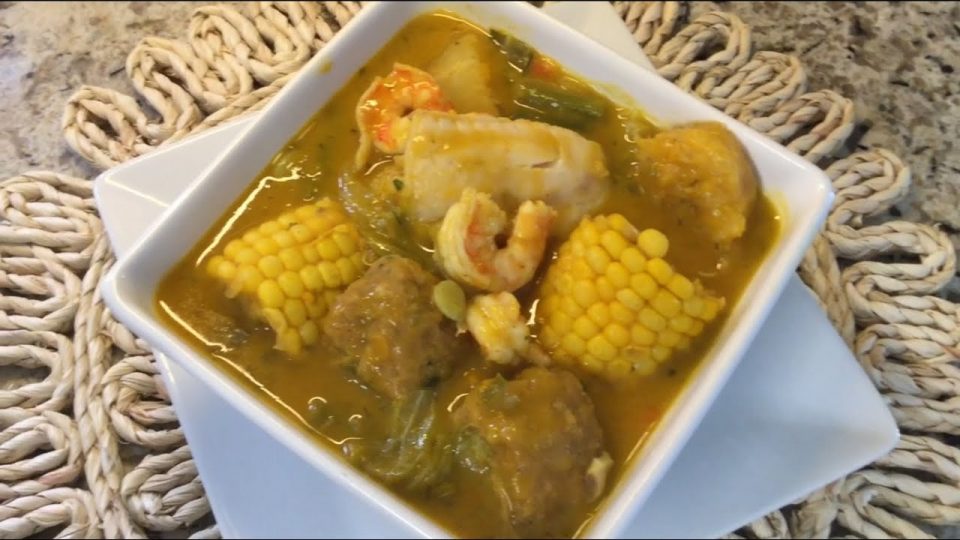
This dish originated in the seaside province of Manabí, as did Panama hats (though that’s another story and has little to do with cuisine). Its most original feature is the ground peanut seasoning, which not only gives this soup a creamy texture but goes surprisingly well with fish, shrimp, and other seafood.
In addition, whole ears of corn are sliced into wheels and their crunchiness is complemented by chewy plantain slices as well as an assortment of vegetables. Like many Ecuadorian soups, this recipe is deceptively simple and can be deviated from at will – but you will not achieve the same flavor as a cook who’s been making it for years.
3. Locro de Papa (Potato Soup)

If peanuts in soup strike you as weird, how about potato and cheese? Cheese in Ecuador, especially queso fresco (unaged cheese), is quite different from what you’re probably used to – it’s porous, tangy, and not hugely flavorful.
Combined with potato, it becomes an extremely hearty soup popular in the colder parts of the Sierra mountains. Other flavorings include cilantro and achiote: a spice native to South America that adds color and flavor. Locro de papa, though not served cold, is typically garnished with slices of avocado and – almost always – chili or hot sauce.
4. Encebollado (Fish Soup)

Encebollado means “with onions.” As it turns out, this is one of the best ways to prepare fresh tuna or albacore. Interestingly, encebollado, though very much on the savory side, is a typical breakfast dish – and it’s prized as a hangover cure!
Aside from a careful balance of flavor between cilantro, seafood, chili (a small amount!), cumin, and other seasonings, what makes this soup special is its garnish: tomatoes and red onions sliced very thinly and marinated in lime juice. This mix is also called curtido de tomate y cebolla and it’s a handy way to liven up all kinds of dishes.
5. Fanesca
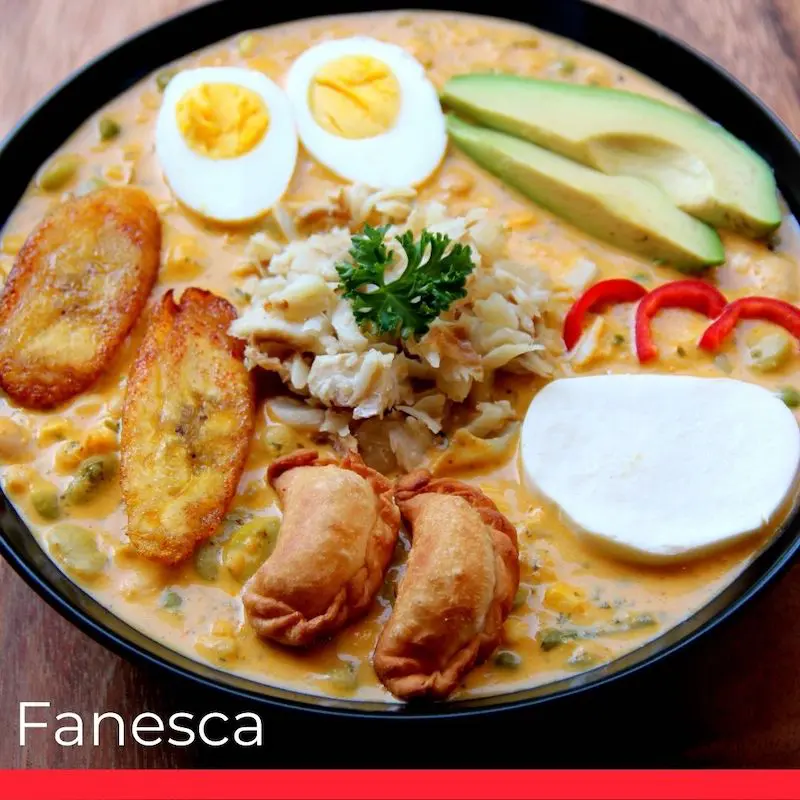
Easter is one of the most important holidays in predominantly Catholic Ecuador. It’s also the only time of year during which fanesca is served. This rich soup takes a while to prepare and is essential to family celebrations.
The ingredients will challenge most pantries: dried cod, beans, cream, cheese, hardboiled eggs, peanuts, squash, rice, corn, onions, and various aromatics go into a perfect fanesca. It may seem intimidating, but the recipe isn’t that hard to follow. The the amount of work needed makes it worth preparing this classic in bulk.
Ecuadorian Seafood Dishes
When it comes to the ocean’s bounty, there’s very little that can go wrong as long as it’s fresh. Contrariwise, no help from man can rescue seafood that’s past its prime. Ecuadorians know this well: in addition to major industries focusing on the export of tuna and shrimp, many tables are supplied by fishermen who brave the ocean on tiny fiberglass boats.
In coastal towns, you’ll find their wares on sale the next morning at the market for way less than they’d cost in a supermarket freezer.
6. Ecuadorian Ceviche (Raw Pickled Seafood)
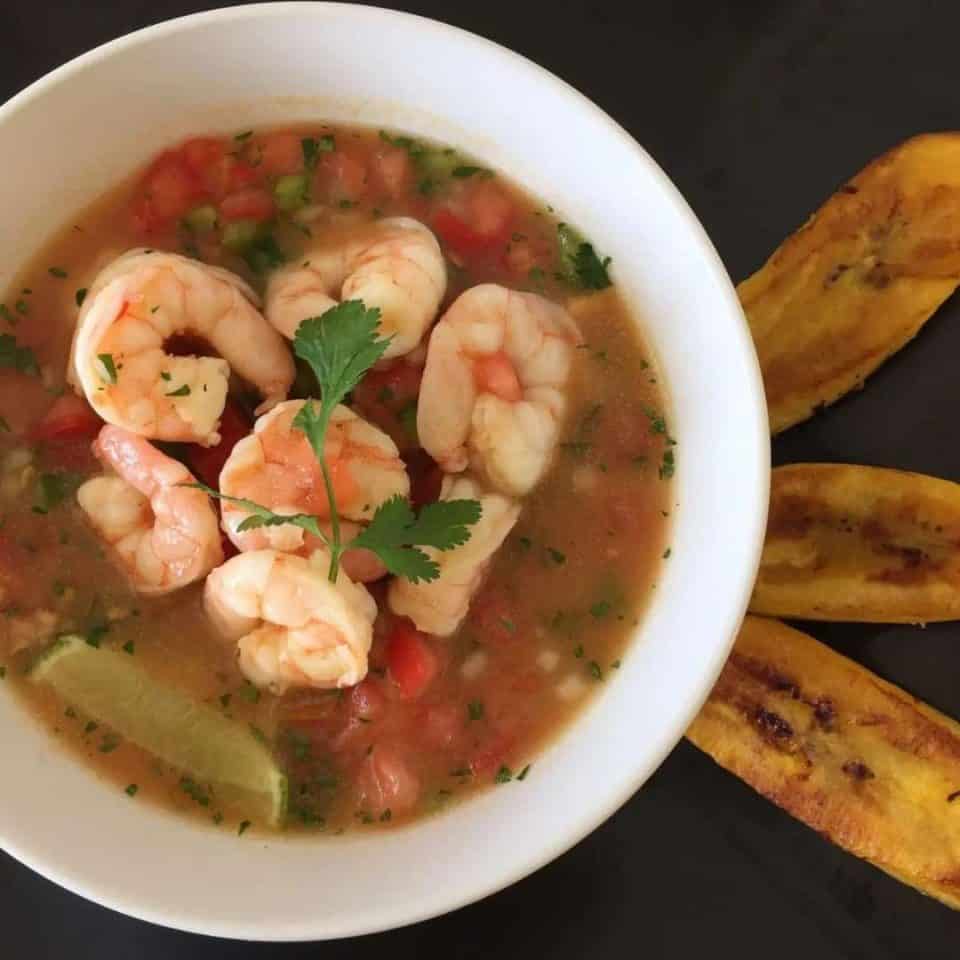
If you thought sushi was the only way to enjoy raw fish, you’ve never tried this dish!
Traditionally, ceviche is made only with seafood (clams, shrimp, squid, fish, or any combination), salt, and lime juice. Rather than using heat for the cooking, the acid in the limes causes a chemical reaction that allows more of the seafood’s natural flavor to shine through.
These days, there’s room for much more significant variation in ceviche recipes, including this one featuring a vegetable garnish and orange juice. Don’t confuse Ecuadorian ceviche with the Peruvian or Mexican versions. It’s more like a soup than a salad and is served with chifles (thinly sliced plantain chips) instead of tortillas or corn kernels. It’s not accompanied by chili: Ecuadorians generally don’t like spicy food, and ceviche is good enough.
You should be aware that ceviche is made with seafood that’s no more than a couple of hours old and is generally served only in the morning. Once the ingredients caught the previous night, run out, restaurants close their doors!
If you’re unsure of your seafood’s freshness, blanche it for safety, as many Ecuadorians do.
7. Chicharrón de Pescado (Deep Fried Fish Pieces)

Popular with fussy children and perfect for sharing among several people, chicharron means “curly” and refers to the shape the chunks of fish take on as they cook. The dish can also be prepared using pork.
This recipe is straightforward – just take care with the breading, which often uses corn flour, breadcrumbs, and wheat flour for the perfect crispy texture.
This dish is typically served with lime wedges, salad, and patacones: fried plantain circles bashed with a unique tool to increase their surface area and then fried again for maximum crunch.
8. Arroz Marinero (Sailor’s Rice)

Though yuca (cassava root), plantain, and potatoes are popular, rice remains the staple starch in Ecuador. Arroz marinero is similar in concept to paella but with a couple of significant differences:
- You don’t need a special wok-like pan to prepare it.
- Saffron is replaced with achiote.
- There’s no crispy crust on the bottom, and chicken and chorizo typically don’t make it into the arroz marinero recipe.
Although this is a special dish, there’s very little involved in preparing it: as long as the rice and the seafood aren’t overcooked, it will be fine.
9. Encocado de Pescado (Fish in Coconut Sauce)

Coconut trees grow wild in much of Ecuador; I have one in my garden. The easiest way to enjoy this highly nutritious food is to chill them and lop the top off with a machete – numerous sidewalk stalls sell nothing but coco helado.
If you want to go to a little more effort, some great dishes are well within your grasp. My favorite coconut dish has to be encocado de pescado, a signature dish from Esmeraldas province. Though best prepared with Pacific sea bass, this recipe is amazingly tolerant of other types of seafood – even shellfish works well. Using fresh coconut in the sauce makes a noticeable difference, but canned will work too.
10. Trucha con Hierbas (Trout with Herbs)

Are river fish seafood? I’ll leave that question to the philosophers, but trout by any name is worth a mention when discussing Ecuador’s best foods. The clear, cold rivers of the highlands are perfect for fish farming, making trout and tilapia very common.
Both are delectable, simply pan fried with butter, but this recipe will find a special place in your heart. Crispy-skinned trout, a careful blend of herbs, and a sauce you make right in the pan will make you nostalgic for Papallacta, even if you’ve never been there.
Ecuadorian Meat Dishes
Compared to Europeans and North Americans, most Ecuadorians eat red meat relatively sparingly, preferring to get their protein from other sources.
If you’re not going to eat a lot of meat, you may as well make every morsel count: Ecuadorian meat dishes aren’t all that complicated but tend to be pretty flavorful and satisfying.
11. Seco de Chivo (Goat Stew)
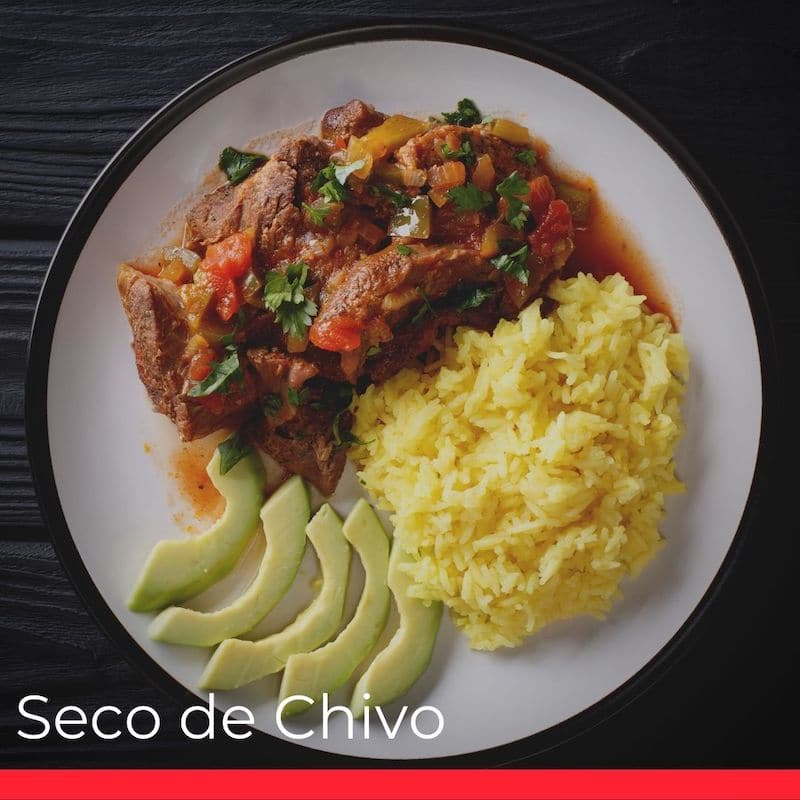
Somewhat confusingly, seco means both “dry” and “stew” in Ecuadorian Spanish, presumably due to how much liquid can boil off from a traditional, slow-braised stew.
What makes this dish special is how the meat (which may also be lamb or goat) is marinated in chicha: an alcoholic beverage made by chewing and spitting corn kernels. The enzymes in human saliva start fermentation, but you may be glad to learn that most restaurants use bottled beer instead.
Apart from cooking and marinating the meat for a long time, the secret to this dish is not to go easy on the aromatics, including (optionally) fruit juice. Goat and lamb have potent flavors and can stand a little spice.
12. Cuy Asado (Roast Guinea Pig)

Fans of Terry Pratchett’s Discworld series will probably remember the fictional Ankh-Morpork delicacy: fried-rat-onna-stick.
Well, this is not only a real thing but a very well-liked one in Ecuador. Though the Inca empire occupied the country for only eight decades, half of that in the north, this is one part of their culture that has endured through the centuries.
Once you get past the fact that you’re eating a rodent served whole, you’ll find it’s delicious. The most significant drawbacks of this delicacy are that it’s costly and doesn’t contain much meat, which you have to suck and nibble off the bones.
13. Churrasco (Steak, Sort Of)

Cattle in Ecuador tend to be free-range rather than penned, corn-fed, antibiotic-saturated, hormonally-fattened cattle. This makes their meat tastier and almost certainly better for you. But, on the other hand, a steak cut from one does require some chewing.Don’t expect to order this medium-rare, but the flavor is generally not disappointing, thanks to a potent dry rub.
The solution is to butcher select parts of the animal into relatively thin cutlets, differentiating
Ecuadorian churrasco from those served in countries with more significant beef industries.
Once cooked on a parrilla (charcoal grill) or flat top, perhaps with a basting sauce, it makes for a substantial lunch accompanied by salad, fried eggs, rice, French fries, and maybe a bean dish.
14. Tonga de Gallina (Chicken Wrapped in Plantain Leaves)

Tonga can take quite a while to prepare: you have to cook rice, prepare a sauce from peanuts, cook a chicken and vegetable stew separately, and only then assemble the whole package and toss it in the steamer or oven.
In times past, this was of a design that hadn’t changed over the previous centuries: basically, a large clay pot sunk into the soil and covered with a lid of some kind. A fire is built on one side while the other is reserved for food.
Making a ton of tongas isn’t much more demanding than producing only a few. This has led to them becoming fixtures at social gatherings, family events, and popular takeaway food.
Packaging a whole meal in a plantain leaf originated with agricultural workers who couldn’t return home for lunch. However, once people realized they had a good thing going, this dish was no longer seen as food only fit for peasants.
15. Arroz con Menestra y Carne Asada (Rice with Menestra and Barbecue)

Although this food is far from sophisticated, it remains a perennial favorite among Ecuadorians. It also lets us talk about menestra: a sauce made from vegetables and either beans or lentils.
Low in calories and high in nutrients, this is a staple every Ecuadorian knows and loves.
This sauce is not exceptionally flavorful. It’s always inoffensive, though, whatever it’s served with, and it has a texture that goes particularly well with rice.
Street Food
Slow food is king in Ecuador; almuerzo (lunch) is a sacred hour best spent around a table with family. So pizza, hamburgers, French fries, and similar junk tends to be reserved for special occasions or days when time is short. Even so, plenty of sidewalk vendors and informal eateries around offer some tastier, healthier options. These are generally not affiliated with any franchise and are the better for it.
16. Empanadas (Filled Pastry Pockets)
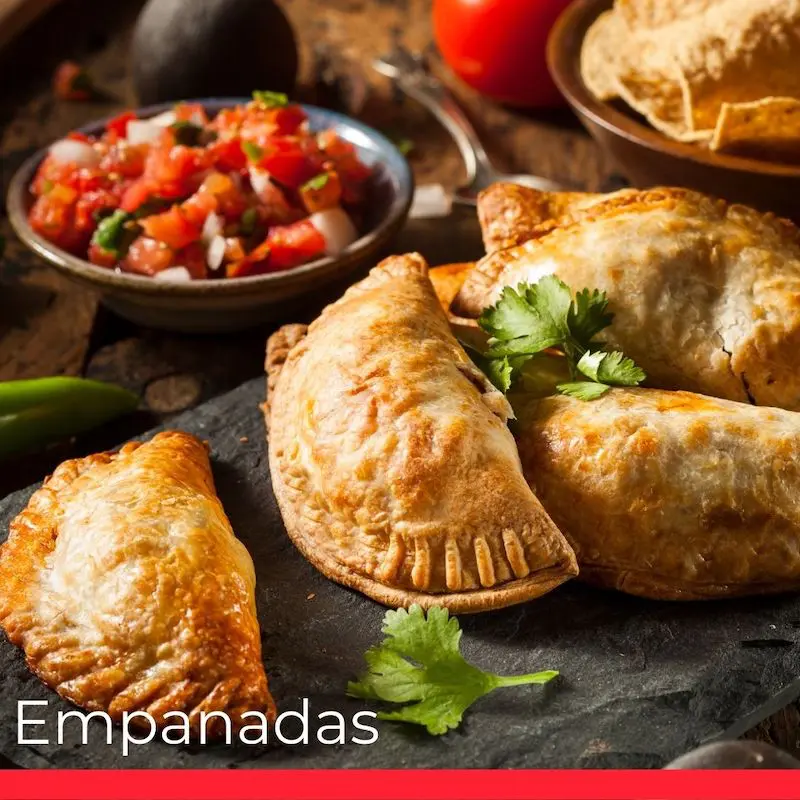
An excellent option for any occasion, from breakfast to midnight snack, these little treats can contain anything from meat to a sweet filling. In addition, they offer a lot of variety in other ways: they can be pan- or deep-fried, or baked, while the dough is often made with mashed plantain or yuca.
If you don’t feel like devoting an entire morning to making a batch, you can always buy the pre-made discs, or a special tool to shape and seal them. Preparing them from scratch is always more satisfying, including a traditional recipe for cheesy empanadas sprinkled with sugar.
17. Corviche (Fish Courgettes)

Corvina (sea bass) might not be the tastiest thing to come out of the ocean, but it’s a strong contender for the title. Combine it with plantain, the vegetable with a thousand and one uses, and you get corviche.
Flavored with finely chopped onion, peanuts, cilantro, and whatever else you can think of, these are deep-fried and taste their best when still piping hot. Make sure to ask what you’re getting when you visit one of the many street stalls that serve these, though: many cooks use the cheaper tuna as a filling, which isn’t nearly as delicious.
18. Muchines de Yuca (Cassava Balls)

Due to its low cost and versatility, cassava root is very popular in Ecuador. You can put it in soup, turn it into a tortilla, prepare it like French fries, or bake it like bread. In the latter case, you can also spice it up with a sweet or savory filling to make muchines.
Filling the dough with cheese and drizzling it with honey is one good option; stuffing it with ground beef is another if you prefer a more savory snack.
19. Humitas (Steamed Corn)

Resembling Mexican tamales, humitas are creamy maize pastries steamed in the leaves from their cobs. Though not too sweet, they go very well with coffee or as a light snack.
Preparing humitas requires a relatively large amount of work, but they freeze well.
20. Torta de Verde (Plantain Pie)

Plantains are eaten when green or ripe, at which point they’re slightly acidic and sweet. In either state, they can be grated or boiled and mashed to create a dough that can be used for various purposes.
One of the best dishes this way is a tortilla containing fish, sausage, cheese, spices, and vegetables for flavor. Even if you’re not incredibly confident in the kitchen, very little can go wrong with this recipe. Whether you want to create individual, bite-sized portions or a larger pie is up to you.
Generally, you’ll pan-fry them in the first case and bake a larger, thicker pie in the oven on medium heat.
Desserts and Sweets
Confectionery styles from abroad have made plenty of inroads in Ecuador, but most people still have a soft spot for the old-fashioned favorites, prepared just like grandma used to make. Even if these dishes don’t interest you, there is always fruit to satisfy your sweet tooth – including some you’ve probably never heard of.
21. Colada Morada (Corn and Fruit Tea)

This sweet drink has plenty of history: it predates Spanish colonists arriving in Ecuador. Back then, it had religious symbolism; even today, it’s traditionally drunk on All Soul’s Day (November 2nd).
You may have some difficulty finding all the ingredients outside Latin America. Specifically, you’ll need purple corn, though some recipes use cornstarch instead to thicken the liquid and a variety of spices, herbs, and fruit for color and flavor.
If you want to get the whole experience of celebrating the day of the dead, you can also bake guaguas de pan: sweet breads in the form of dolls.
22. Morocho (Milk Cereal)

Morocho resembles rice pudding, except that it uses broken brown corn instead of rice and has a texture similar to a milkshake. This special corn, of course, provides this dish’s principal flavor and combines it with cloves, cinnamon, raisins, and panela (whole, unrefined sugar).
Also, like rice pudding, you have to cook it for an incredibly long time and soak the corn first. Never fear, though: plenty of stalls and restaurants in Ecuador will be happy to serve you a portion.
23. Rompope (Eggnog)

Everybody loves eggnog. In Ecuador, it’s less of a seasonal treat, because it’s sold and enjoyed all year-round.
Traditionally, it’s made with either rum, brandy, or aguardiente. The latter type of liquor is not exceptionally tasty – but it’s basically gasoline – so take care!
24. Membrillo (Quince Paste)

Quince isn’t very sweet (at least, not in terms of Ecuadorian desserts), yet it does have a unique flavor. Preparing a jam from it takes a long time, and you have to pay attention when you do, but at least it stores well. Many people like to pair it with a bit of cheese for dessert or use it as an ingredient in cookies.
25. Torta de Higo (Fig Cake)

Among numerous other fruits, figs are greatly loved in the Andes region. They’re typically marinated and cooked in syrup, as the temperature makes it difficult to ripen completely. Another way to take advantage of their natural sweetness and flavor is to include them in a cake, examples of which you’ll find in numerous pastelerias (pastry shops).
This recipe can be as straightforward or as complicated as you wish. You will find that using ingredients like nuts, orange marmalade, and spices leads to a better result, though, so putting in the time will be worthwhile.
In conclusion, Ecuador is most definitely a tourist’s paradise.You can have world-class tropical kitesurfing and birdwatching experiences one day, climb a snow-covered mountain or active volcano the next, return to Quito to admire centuries-old architecture and artwork before partying the night away, then round out the week with a guided tour of parts of the Upper Amazon that are only accessible by canoe.
And between all that, you now know you can enjoy some truly unique tastes.
If you’re more of an armchair traveler, you can still try out some of these dishes even if there isn’t an Ecuadorian restaurant in your neck of the woods. Finding ingredients such as plantains and panela may be challenging, but replicating most of these dishes isn’t hard. This recipe book strikes a good balance between authenticity and simplicity. In addition, it’s bilingual, which may prevent you from accidentally ordering Sopa de mondongo (tripe soup) should you visit.
Related: Most Popular Christmas Foods in Ecuador

Related: Most Popular Desserts in Ecuador

The post Top 25 Foods of Ecuador: From the Beach to the Amazon appeared first on Chef's Pencil.
from Chef's Pencil https://ift.tt/TbtcFxX
via https://chefsspenncil.blogspot.com

No comments:
Post a Comment